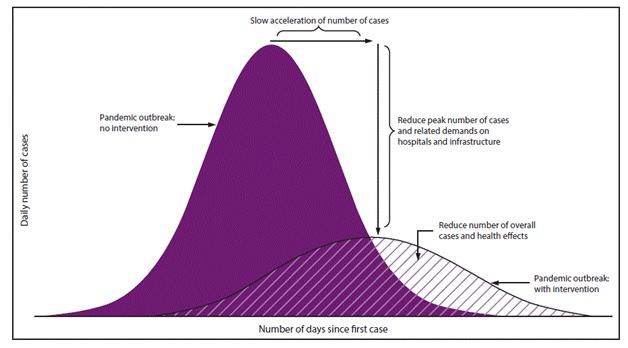Social distancing is a non-pharmaceutical infection prevention and control intervention implemented to avoid/decrease contact between those who are infected with a disease causing pathogen and those who are not, to stop or slow down the rate and extent of disease transmission in a community.
Social distancing is a term applied to certain to stop or slow down the spread of a highly contagious disease. Since these measures will have a considerable impact on our community, any action to start social distancing measures would be coordinated with local agencies such as cities, police departments and schools, as well as with stakeholders.
Social distancing measures are effective when the infectious disease spreads via droplet contact (coughing or sneezing); direct or indirect physical contact; or airborne transmission (if the microorganism can survive in the air for long periods).
What are the social distancing measures?
Social distancing measures are taken to restrict when and where people can gather to stop or slow the spread of infectious diseases. Social distancing measures include limiting large groups of people coming together, closing buildings and cancelling events.
Why would social distancing measures be used?
Today, social distancing measures are most often thought about as a way to slow the spread of a pandemic disease. Health experts have looked at past pandemics and found that during the 1957-58 pandemic, the spread of the disease followed public gatherings such as conferences and festivals. And during this pandemic, the highest attack rates were seen in school children, due to their close contact in a crowded setting. Health experts believe that avoiding crowds of people will be critical in slowing the spread of any pandemic disease.
Since a pandemic cannot be stopped once it has started and because health experts do not know how much warning there will be, once a pandemic is found, social distancing measures are used early on to slow the spread of the disease and provide the community with the valuable time needed to be better prepared.
The social distancing measures that are usually used during a pandemic broadly include closing all public and private academic setup and facilities, closing all childcare centres, community centres, malls and theatres, as well as suspending services at all houses of worship. Additionally, during a pandemic, all indoor and outdoor events that attract large crowds are cancelled. These events include sports events, concerts, parades and festivals. Mass transit systems are temporarily closed or be used only for essential travel.
What other public health actions help limit the spread of disease?
Other public health actions that are used to limit the spread of infectious disease include isolation and quarantine. Isolation is used when a person is sick and has a contagious infection. The sick person is separated from people who are not sick. People who are isolated may be cared for in hospitals, other healthcare facilities and in their own homes. In most cases, isolation is voluntary, but state and local health officials have the power to require the isolation of sick people to protect the general public's health.
When a person is placed in quarantine, they are also separated from others. Even though the person is not sick at the moment, they were exposed to a contagious disease, may still become infectious and then spread the disease to others. Other quarantine measures include restricting the travel of those who have been exposed to a contagious disease, and restrictions on people coming or going into a specific area. States have the power to enforce quarantines within their borders. Both isolation and quarantine may be used by health officials during a pandemic to help slow the spread of the disease.
What can you do?
Even though it may seem simple, practising good hygiene habits such as washing your hands and covering your cough will help to stop or slow the spread of the pandemic. During a pandemic, it is critical to understand what you may be asked or required to do. It will be important to follow any Public Health social distancing instructions or any other instructions or orders that may be given. So please stay informed and plan.
Social distancing in India will flatten the curve: Mathematical modelling by ICMR
Based on the initial understanding of the spread of COVID-19 infection, the mathematical modelling done by ICMR suggests that entry screening of travellers with symptoms suggestive of COVID-19 can delay the introduction of the virus into the communityby 1-3 weeks. Strictly implemented social distancing measures such as home quarantine of symptomatics and suspected cases will reduce the overall expected number of cases by 62% and the peak number of cases by 89%, thus 'flattening the curve' and providing more opportunities for interventions. These model projections are subject to substantial uncertainty. They can be further refined as more needs to be understood about the rate at which infection of this novel virus transmits among susceptible individuals.
What "Safer at Home" means for you?
This means when you're using shared or outdoor spaces other than your home or residence, you must keep a physical distance of six feet from other people who aren't part of your household. This is called physical distancing.
How Safer at Home and physical distancing help you and others stay healthy?
Protective measures like Safer at Home and physical distancing are the best tools to 'flatten the curve.'In other words, decrease the daily number of cases of a contagious disease. Physical distancing is effective in slowing the rate of infection. During an outbreak like COVID-19, a large number of ill people at once can quickly overwhelm local hospitals and clinics.

References: